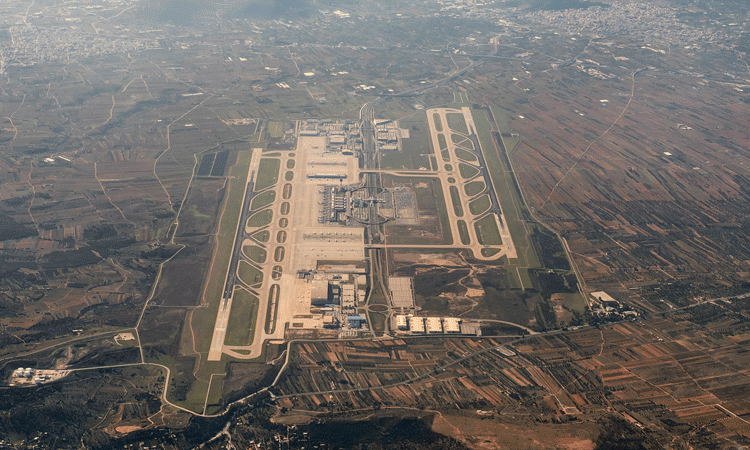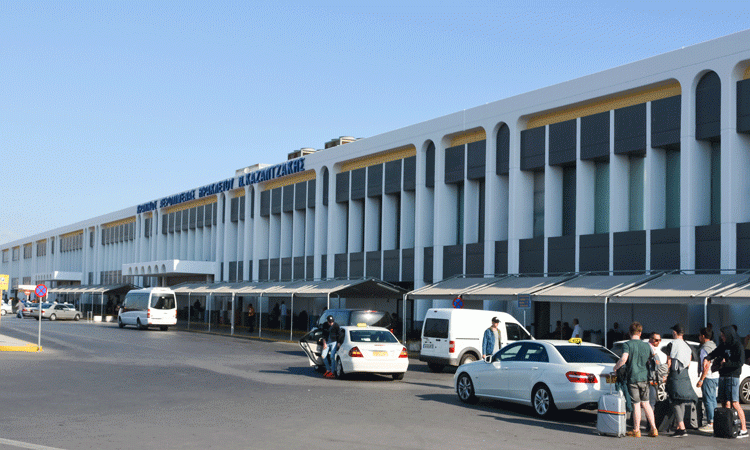Looking into the history, and the future, of Greek aviation
- Like
- Digg
- Del
- Tumblr
- VKontakte
- Buffer
- Love This
- Odnoklassniki
- Meneame
- Blogger
- Amazon
- Yahoo Mail
- Gmail
- AOL
- Newsvine
- HackerNews
- Evernote
- MySpace
- Mail.ru
- Viadeo
- Line
- Comments
- Yummly
- SMS
- Viber
- Telegram
- Subscribe
- Skype
- Facebook Messenger
- Kakao
- LiveJournal
- Yammer
- Edgar
- Fintel
- Mix
- Instapaper
- Copy Link
Posted: 4 November 2019 | Konstantinos N. Malagas | No comments yet
Konstantinos Malagas, Research Associate for the Laboratory of Informatics and New Technologies in Shipping, Transport and Insular Development, presents the current state of Greek airports, the intentions of the Greek government, and prospects within the industry.


Air transport is a key driver of economic activity in Greece, supporting 457,000 jobs and contributing €17.8 billion to the Greek economy – equivalent to 10.2 per cent of the Greek GDP (as found in an IATA study). The contribution of Greek airports towards tourism and the country’s economy is significant. The Greek State selected a public-private partnership (PPP) form – involving a combination of private and public shareholders – to manage the bigger airports and appears to also prefer this for the smaller airports. However, independently of the ownership status, the airports run as business entities and are managed on a purely commercial basis, focused on air connectivity development, operational efficiency, service quality and revenue diversification. This requires sustainable investment.
There is an increased trend for airport privatisation and, according to ACI, this attributed to deliberate policy choices, state budgetary constraints and the need to promote air connectivity by investing in the development of airport infrastructure. Today, three out of four passengers are travelling through an airport with private shareholders and the rise of privatisation has become more prevalent at EU airports in comparison to their non-EU counterparts. However, private shareholders have a stronger interest in the larger airports as the smaller regional airports tend to be unprofitable.
The current Greek aviation industry
Athens International Airport
Athens International Airport (AIA) opened in March 2001 and greatly impacted the Greek aviation industry by becoming one of the most modern, safe and functional airports in the world. With two parallel runways – four kilometres and 3.8km respectively – the airport served 24.1 million passengers in 2018 (compared to 21.7 in 2017) and had 217,094 aircraft movements (compared to 195,951 in 2017), whilst the airport’s revenue grew to €478.71 million (an increase of 10.4 per cent) and its net profits stood at €171.69 million.
AIA – through its strong incentive policy, extensive range of joint promotional and advertising activities and the provision of key information, such as customised market analysis, traffic forecasts and feasibility studies – attracts new airlines, which in turn benefits tourism and the Greek economy. The airport followed a PPP scheme, where the ownership is divided between the Hellenic Republic (Greek State) and private sector (Public Sector Pension Investment Board of Canada (40 per cent) and Copelouzos Group (five per cent) in a 55:45 stake. The Greek Parliament recently validated a 20-year extension of the ownership agreement of the AIA (which came into force in February 2019), for the period between 2026 and 2046, and, from then, the ownership of the airport will return entirely to the Greek state.


Aerial view of Athens International Airport
The new contract will include a further €2.9 billion investment for the airport, which will come at a later time, as arrivals to the airport are expected to increase further. In addition, the government plans to immediately sell 30 per cent of the AIA, with significant interest from foreign and Greek investors.
AIA has ambitious plans for the following years in order to accommodate increases in passenger traffic. A significant expansion is planned in a six-phase framework, where the final phase will allow the airport to accommodate 50 million passengers annually, with the current layout leaving enough space for five more terminals to be added. The most recent expansion started in March 2018 and was completed in mid-2019 – the South Wing Expansion (SWE) Project broadened the main terminal building by 3,700m2.
Heraklion Airport
The biggest state-owned airport in Greece is Heraklion Airport, which saw almost eight million passengers in 2018. Located in Crete, the airport attracts a considerable number of tourists. The airport terminal was extended following significant renovations, including an expansion of 2,895m2 and a full refurbishment of the existing 8,000m2, increasing terminal capacity and improving passenger services.
An important issue for the Greek aviation industry is the construction of the new Heraklion Crete International Airport SA, which will be located in Kasteli and replace the current airport. The new airport will be co-managed by the Greek State, the consortium of Greek GEK TERNA and the Indian GMR, which will retain the majority stake and management of their operating company – about 46 per cent Greek state and 54 per cent private joint venture.


Heraklion Airport
The new airport’s main building, with a total surface area of 71,620m2, will feature 19 passenger waiting rooms and a 3,200m runway. The total investment will be €480 million and is expected to be completed in five years once work begins. The project is anticipated to create 1,500 jobs during the construction period and, according to an Air Transport Action Group (ATAG) study, some 7,500 direct employment positions once completed. An additional 37,000 indirect jobs are projected to open up in the areas of tourism and trade.
Heraklion International Airport will be the only large airport that is owned solely by the state, and the construction of the new airport may delay the progress of the ownership status of the current one. However, the passenger traffic of Heraklion Airport is increasing every year and further expansion is needed to accommodate the additional traffic.
Fraport Greece
Concerning the other Greek airports, during December 2015, Fraport signed an agreement with the Hellenic Republic Asset Development Fund (HRADF) and the Greek State to manage, operate, develop and maintain the 14 regional airports for the following 40 years. Fraport Greece was established, and the German airport operator Fraport AG and the Greek business development organisation, Copelouzos Group, were the shareholders. Fraport Greece groups the airports in the following two clusters: Cluster A, consisting of Aktion, Chania, Kerkyra, Kavala, Kefalonia, Thessaloniki and Zakynthos; and Cluster B, consisting of Kos, Mytilene, Mykonos, Rhodes, Samos, Santorini and Skiathos.
During the initial phase in 2017, Fraport Greece made a full payment of €1.234 billion to the Greek State as a concession fee. Then, an annual fixed concession fee of €22.9 million and a variable annual concession fee of on-average 28.5 per cent of the operational profit are paid. In addition, €1 per departing passenger was paid to the Greek State to finance the Civil Aviation Authority, the state-managed airports and routes under the public service obligations scheme. Approximately €13 million per year is also paid for the provision of services by the Greek Fire Brigade and the Hellenic Air Force.
Investing into the future of Greek airports
Fraport Greece will further invest €400 million into improving and expanding the airports’ infrastructures by 2021, focusing on enhancing facilities, operational processes and the passenger experience. The traffic results are encouraging for both clusters, as the following table shows:
| 2017 | 2018 | 2018 vs 2017 (%) |
Cluster A | 15,404,230 | 16,616,973 | 7.9% |
Cluster B | 12,029,678 | 13,262,821 | 10.3% |
Total | 27,433,908 | 29,879,794 | 8.9% |
The 14 Greek regional airports project is one of the largest and most beneficial investments to boost the Greek economy, especially during this challenging time for the country, reinforcing the competitiveness of the economy and generating new jobs. Great efforts have been made by Fraport-Greece to modernise the airports in order to respond better to operational and commercial needs. Thus, the works at the airports of Zakynthos, Chania and Kavala have been completed, whilst works at Samos, Mytilene, Rhodes, Skiathos, Kefalonia and Aktion will gradually be completed by the end of 2019. The upgrading programme and modernisation of the infrastructure at Kos, Santorini, Mykonos, Corfu and Thessaloniki will be completed by 2021 – these works are focused mainly on the extension of the terminals and runway improvements.
The open issues for the Greek State
For the 23 smaller regional airports, each has been categorised based on their passenger traffic and potential investment interest into three groups or clusters. The first group includes airports with over 100,000 passengers per year, and these are: Karpathos, Chios, Kalamata, Alexandroupolis and Araxos.
The second category includes airports with annual passenger traffic between 30,000 and 100,000 passengers, which are those in Lemnos, Ioannina, Milos, Naxos, Paros, Ikaria and Kythira. It should be noted that some of them have exceeded the 2015 figures, when those were set.
Finally, the third category – for which investment interest is estimated to be non-existent – includes airports with less than 30,000 passengers annually and contains the airports in Leros, Sitia, Nea Anchialos, Kalymnos, Skyros, Syros, Astypalaia, Kastellorizo, Kastoria, Kassos and Kozani. The state’s objective is to co-operate with private investors and to find a PPP scheme similar to the 14 airports managed by Fraport, though this is not an easy task.
The concession of the 23 airports – either as a group or separately – is being examined. However, it is not certain that investors will be interested in airports with such low levels of passenger traffic.
Suggestions for future development
There is considerable space for improvement regarding the country’s airports, including the adoption of more aggressive strategies. Extending the tourism seasonal traffic and attracting higher income passengers are the two most important challenges for the Greek tourism and aviation industry. This should be achieved through close co-operation with tourism businesses and local authorities. Moreover, emphasis should be placed on other forms of tourism – such as agrotourism, health tourism and sports tourism.
The development of intermodal transportation may assist airports in increasing passenger traffic and revenues, based on better use of the existing infrastructure. The improvement of connectivity of air with ferry and rail transportation and co-operation with airports from neighbouring countries is important. Furthermore, emphasis on the needs of passengers with reduced mobility (PRM) may increase passenger traffic all year round, and a focus on the Greek diaspora (seven million Greeks live abroad) is an important issue for the aviation industry.
The above requires hard work and co-operation by all interested parties. These briefly presented initiatives will contribute to the further development of Greek airports, providing significant benefits to the local areas and to the country’s economy. These initiatives may require some significant investment, which the state alone should pay, or payment should come through European funds and private investors.
Biography
Konstantinos N. Malagas, Β.Sc., M.Sc., M.Phil., Ph.D., Post Doc, Research Associate, Laboratory of Informatics and New Technologies in Shipping, Transport and Insular Development (LINTSTID), Department of Shipping Trade and Transport, University of the Aegean.
Related topics
Airport development, Passenger volumes, Regulation and Legislation


















